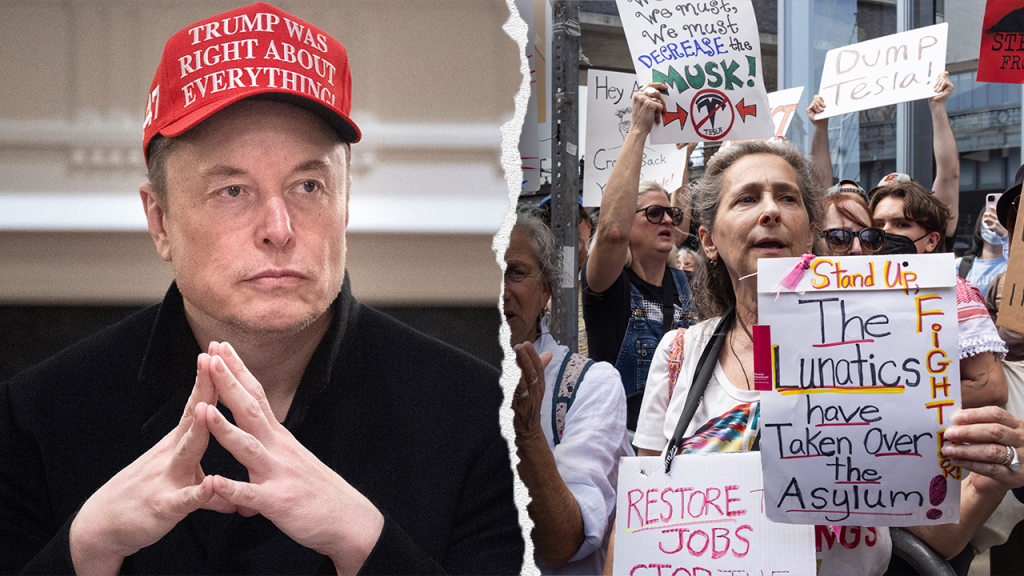Protests erupted across the United States over the weekend, primarily at Tesla showrooms, as demonstrators expressed their outrage over CEO Elon Musk‘s involvement in President Donald Trump‘s Department of Government Efficiency. Dubbed the “Tesla Takedown,” these protests were not limited to the U.S.; hundreds more were planned in Canada and Europe as part of a global effort against Musk and Trump’s administration. While organizers branded these events as grassroots movements, questions arose regarding their funding and organization.
| Article Subheadings |
|---|
| 1) Overview of the Protests |
| 2) Details Behind the Organization |
| 3) The Nature of the Demonstrations |
| 4) Reactions and Repercussions |
| 5) Background of Government Oversight |
Overview of the Protests
The protests that unfolded this past weekend were part of a larger movement, with over 200 demonstrations taking place in various locations across the United States. Organized by a coalition of actors, filmmakers, lawmakers, and activists, the “Tesla Takedown” aims to raise awareness about Musk’s role in Trump’s government and its implications for both the auto industry and public policy. The nationwide protests attracted significant media coverage, with numerous outlets describing them as a grassroots effort to challenge the Tesla CEO and his political affiliations. Participants were incredibly diverse, encompassing a broad spectrum of individuals united in their discontent.
Details Behind the Organization
The interwoven fabric of these protests raises intriguing questions about their organization and funding. Observers noted that while the protests aimed to present a legitimate grassroots uprising, there were claims of “astroturfing,” a term which implies a false appearance of organic movement funded by larger organizations. Some commenters, including podcast host Joe Rogan, speculated that the demonstrations might have been supported financially, suggesting that many participants may have received payment to attend. The various groups behind the protests—such as Indivisible and MoveOn.org—have thus far refrained from publicly addressing these allegations, further fueling the fire of skepticism. Concerns about whether funds were improperly utilized to mobilize people for the protests have become a focal point of the discussion surrounding the demonstrations.
The Nature of the Demonstrations
Described by organizers as peaceful, the protests featured a variety of creative expressions, including line dancing, sign-making, and chanting slogans against Musk. While most gatherings remained nonviolent, there have been reports of some incidents that raised concerns about safety and vandalism. Signs urging people not to buy Tesla vehicles or calling for Musk’s ousting drew attention to the objectives of the movement. Crowds varied, with some locations attracting hundreds of individuals, while others saw smaller groups. Noteworthy protests, like those in New York and Chicago, gathered significant numbers, serving to amplify the collective dissent against Musk and his policies. Despite the atmosphere of discontent, organizers insisted on maintaining a nonviolent approach, hoping to dissociate themselves from any acts of vandalism or aggression towards Tesla properties.
Reactions and Repercussions
Reactions to the protests ranged from support among activists to criticism from conservative commentators and Tesla proponents. Musk himself took to social media to question who was funding the protests, expressing skepticism about their grassroots label. Echoing this sentiment, some media personalities described the demonstrations as being orchestrated by larger political organizations rather than emerging out of genuine public sentiment. This skepticism has resulted in heightened scrutiny around the motivations behind the protests, raising eyebrows about the integrity of civic engagement in the current political climate. National reaction has been mixed, and the potential repercussions for Tesla’s reputation and Musk’s operations could be significant.
Background of Government Oversight
The impetus for the protests largely stems from Musk’s collaboration with Trump’s Department of Government Efficiency, aimed to root out waste and inefficiency in federal agencies. The formation of DOGE, the Department of Government Efficiency, added complexity to the scenario, as critics alleged that this initiative epitomized the merging of corporate interests with governmental authority. The history of this collaboration has incited fears among advocates for consumer rights and systemic transparency, given Musk’s position as a billionaire businessman with substantial influence over public policy. As protests against Tesla intensified, the calls for more stringent regulations and oversight of billionaire influence in government intensified, sending ripples through political discourse.
| No. | Key Points |
|---|---|
| 1 | Over 200 protests occurred across the U.S. targeting Tesla and Elon Musk. |
| 2 | Concerns were raised over potential funding and organization of the protests. |
| 3 | Most protests were peaceful, featuring creative expressions against Musk. |
| 4 | Mixed reactions from the public and media regarding the motives behind the demonstrations. |
| 5 | Protests stem from Musk’s role in the government aimed at increasing efficiency and oversight. |
Summary
The recent protests against Tesla and Elon Musk highlight the increasing tensions between corporate influence and public policy, revealing a deeper societal concern about transparency and accountability in government. The alleged use of funding to organize what appeared to be grassroots movements introduces questions regarding civic authenticity. As lawmakers respond to these protests and as movements gain traction, the potential implications for policy reform and corporate governance remain to be seen. The outcome of these protests could significantly shape the narrative surrounding billionaires and their involvement in government affairs.
Frequently Asked Questions
Question: What is the Tesla Takedown movement?
The Tesla Takedown movement comprises a series of protests aimed at criticizing Elon Musk’s involvement in the Trump administration and its influence on public policy.
Question: Why are protesters concerned about Elon Musk’s role in government?
Protesters are concerned that Musk’s collaboration with the government, particularly the Department of Government Efficiency, represents a merging of corporate interests with public policy, potentially leading to less transparency and accountability.
Question: Were the protests peaceful?
While most protests claimed to be peaceful with expressions of dissent and creativity, there were isolated incidents that raised safety concerns and prompted discussions about vandalism and violence.


